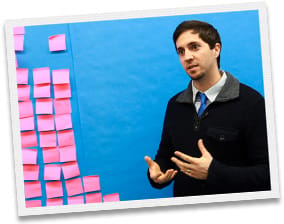Educators across the nation have been using Design Thinking to solve challenges in their work. Projects range in scope and scale including design solutions- from curriculum, to space, to processes and to systems- addressing problems in the classroom and across entire districts.
How might my classroom be redesigned to better meet my students' needs?


Michael Schurr, a 2nd grade teacher in New York, realized that he never asked his students what would make them comfortable in the classroom. He decided to talk directly with his students to figure out the best design for their environment.
Based on his students' input, he was able to redesign his classroom to better address the needs and desires of his students. He lowered the bulletin boards so that his students could actually see the content he'd spent hours assembling, and created a more comfortable semi-private space for the students to study by rethinking the student cubby space. His students are more engaged, and move more fluidly in the classroom space. Now Michael consistently engages his students in helping him more effectively shape their learning experience.
Michael is using design to re-imagine his classroom through the lens of his students' needs.
How might we create a 21st century learning experience at our school?


The faculty at Ormondale Elementary School in California wondered if they were preparing their students well for the future. They decided it was time to corroboratively design an approach to teaching and learning that they felt was updated and relevant for the 21st century.
Collectively, they embarked on a design journey and came to an approach they call "Investigative Learning", which addresses students not as receivers of information, but as shapers of knowledge. The faculty continues to evolve and share this approach with new teachers through the creation of a Manual of Investigative Learning to keep track of their philosophy and methods. They have gained support from their school board, and have become recognized as a California Distinguished School.
The faculty at Ormondale Elementary School uses design to address the needs of their evolving student body.How might we redesign our approach to curriculum development and delivery to center around the needs and desires of our teachers and students?


With a movement toward student-centered and personalized instruction, the Howard County Public School System in Maryland is using Design Thinking to tackle next generation curriculum redesign incorporating 21st Century skills. Currently, there is a disconnect between the existing paper-based curriculum and the interactive digital resources that are now available anytime, anywhere for teachers and students.
Tapping into teacher, parent, and student behaviors in and outside of school, the design team collected inspiration around the ways that people engage with information and interact with curricular materials. Understanding the desires of teachers, students, parents, and administrators has helped the team rethink curriculum delivery as well as develop resources to replace, augment, and enhance current curriculum documents.
Howard County is using design to re-conceptualize curriculum creation and delivery to meet the needs of all learners.How might we redesign our high school to elevate student engagement and
academic outcomes?


Consistent low student achievement results at Castle High School in Hawaii demonstrated the need for a redesign and restructure of the school. Design Thinking Hawaii, a non-profit organization that engages volunteers to apply Design Thinking to big challenges, partnered with the Hawaii Department of Education to reimagine the Castle High experience.
Through a series of mini-charettes, Design Thinking Hawaii has collected the needs and interests of learners, teachers, and families and engaged the larger community to imagine new solutions that could help the school be more effective. The adopted plan captured the community's priorities in new content and structures, and Complex Area Superintendent Lea Albert is enabling the school and community to prototype and iterate core curriculum, character education, and support services. This is the first public-school model in Hawaii to co-design its offerings with community, targeting systemic educational problems.
Design Thinking Hawaii is using design to provide the state with input that will shape the redesign of Castle High and other schools in the community. Share A Story: Design Thinking for Educators Page 3 Page 5
Share A Story: Design Thinking for Educators Page 3 Page 5